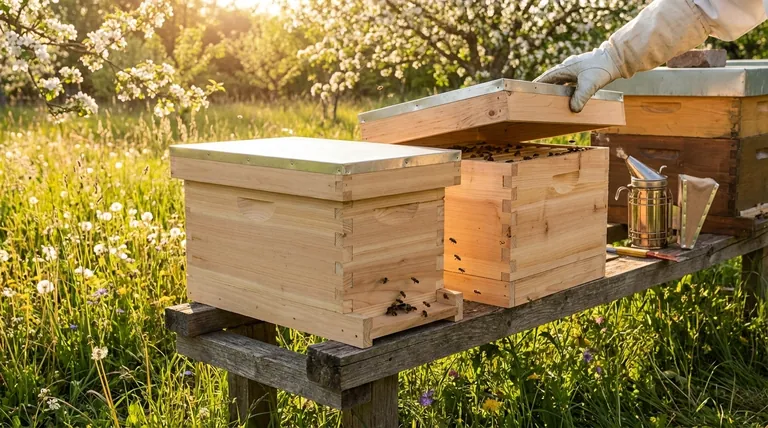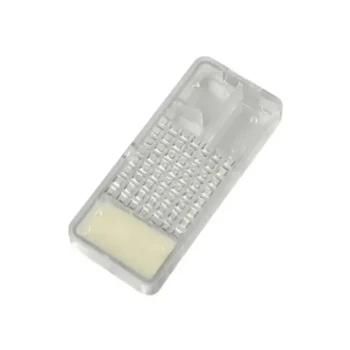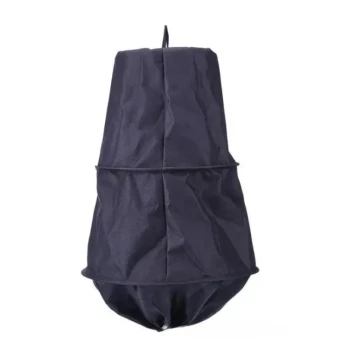In beekeeping, a nucleus colony, or "nuc," is a small, functioning honey bee colony housed in a smaller-than-standard box. Far more than just a starter hive, a nuc serves as a versatile management tool used to solve queen problems, prevent swarming, strengthen weak hives, and expand an apiary. They are an indispensable resource for managing the health and productivity of any beekeeping operation.
A nucleus colony is not simply a small beehive; it is the beekeeper's single most versatile tool for ensuring apiary resilience, solving urgent problems, and enabling sustainable growth.

The Nuc as a Core Management Tool
Think of a nuc not as a separate entity, but as a reserve of critical resources—bees, brood, and a laying queen—that can be deployed to solve the most common and urgent challenges in your apiary.
Solving Queen Problems
A colony's survival depends on a healthy, productive queen. A nuc provides a perfect, low-risk environment to manage queen-related issues.
You can use a nuc to house a backup queen. If a large, productive colony suddenly becomes queenless, you can quickly introduce the queen and frames from your nuc to save it.
Nucs are also ideal for raising new queens or allowing newly mated queens to establish a solid laying pattern before they are introduced into a much larger colony.
Preventing Swarms
Swarming is a natural reproductive instinct where a colony splits, with the old queen and about half the bees leaving to find a new home. This drastically reduces the honey production of the original hive.
To prevent swarming in a strong, congested colony, you can pull a few frames of brood and bees out and use them to create a nuc. This relieves congestion in the strong hive, resetting its swarm impulse and keeping it focused on honey production.
Strengthening Weak Colonies
A weak colony may struggle to build up its population, defend against pests, or survive winter.
A strong nuc acts as a resource bank. You can transfer a frame of capped brood from the nuc to the weak colony. As these new bees emerge, they provide a critical population boost, helping the weaker hive recover.
The Strategic Role of Nucs
Beyond immediate problem-solving, nucs are fundamental to the long-term strategy and growth of your beekeeping operation.
Making Colony Increases (Splits)
The most common way to create new bee colonies is by "making a split." A nuc is the primary tool for this process.
You simply take frames of brood, honey, and pollen from a strong colony, place them in a nuc box, and introduce a new queen (or a queen cell). This nuc will then grow into a full-sized colony.
Disease and Pest Management
Nucs can function as a "hospital" or quarantine unit. If you suspect a problem in a hive, you can move a frame of brood to a nuc for closer observation without putting your other colonies at risk.
Creating Economic Value
Healthy, overwintered nucleus colonies are a high-value product. Many beekeepers supplement their income by raising and selling nucs to new or expanding beekeepers.
Practical Considerations and Trade-offs
While incredibly useful, the effectiveness of a nuc depends on proper management and equipment.
The Five-Frame Standard
The five-frame nuc is the most common standard. Its key advantage is its compatibility with standard 10-frame hive equipment.
This allows for easy transfer of frames between boxes and the use of standard feeders or queen excluders.
Management Requires Adaptation
The specific techniques for using nucs can vary based on your climate and local conditions.
For example, the timing for making splits or the resources needed to overwinter a nuc successfully will differ significantly between a cold northern climate and a warmer southern one. You must adapt your management to fit your environment.
How to Integrate Nucs into Your Apiary
The way you use nucs should align directly with your beekeeping goals. They are not just for beginners; they are a sign of a proactive and well-managed operation.
- If your primary focus is growth: Use nucs as the engine for making splits and expanding your number of colonies.
- If your primary focus is honey production: Use nucs to prevent swarming and keep your production colonies strong and populous.
- If your primary focus is resilience: Maintain at least one "resource nuc" throughout the season as a backup to solve any unexpected queen or colony strength issues.
Ultimately, incorporating nucs into your apiary transforms you from a reactive beekeeper into a strategic manager of your colonies' health and success.
Summary Table:
| Primary Function | Key Benefit | Action |
|---|---|---|
| Queen Management | Solves queenlessness, provides backup queens | House and raise queens in a low-risk environment |
| Swarm Prevention | Reduces colony splitting, maintains honey production | Relieve congestion by removing frames of brood and bees |
| Colony Strengthening | Boosts weak hive populations for better survival | Transfer frames of capped brood from nuc to weak hive |
| Apiary Expansion | Creates new colonies sustainably through splits | Make splits using frames from strong colonies and a new queen |
Ready to integrate this indispensable tool into your operation?
HONESTBEE supplies commercial apiaries and beekeeping equipment distributors with the durable, compatible nuc boxes and supplies needed to effectively manage colony health and drive growth. Our wholesale-focused operations ensure you get the reliable equipment your strategic management depends on.
Contact HONESTBEE today to discuss your nuc and equipment needs and build a more resilient, productive apiary.
Visual Guide

Related Products
- 5 Frame Wooden Nuc Box for Beekeeping
- Twin Queen Styrofoam Honey Bee Nucs Mating and Breeding Box
- Automatic Heat Preservation 6 Frame Pro Nuc Box for Honey Bee Queen Mating
- Plastic Transporting Bee Packages and Nuc Boxes for Beekeeping
- Styrofoam Mini Mating Nuc Box with Frames Feeder Styrofoam Bee Hives 3 Frame Nuc Box
People Also Ask
- What frames should be moved into the queenless hive when requeening with a nuc? Ensure a Successful Queen Introduction
- How should the nuc be installed in the apiary? Ensure Colony Success from Day One
- How many frames does a typical wooden nuc box hold? A Guide to Choosing the Right Size
- What are the benefits of moving nuclei around the apiary? Master Strategic Hive Management
- What is a common feature of many 5-frame nuc boxes? The Integrated Feeder for Efficient Colony Growth



















